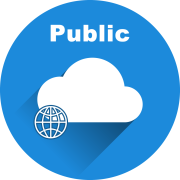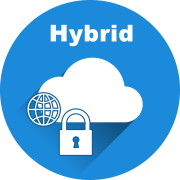What Is The Cloud
Simply put, cloud computing is the delivery of shared, on-demand computing services over the Internet (“the cloud”) to offer faster innovation, flexible resources, and economies of scale.
These services can include servers, storage, databases, networking, software, analytics, intelligence, and more. You typically pay only for what you use, helping lower your operating costs, run your infrastructure more efficiently, and scale as your business needs change.

The most popular form of cloud is public cloud. This is where a third-party service provider grants multiple users access to the same pool of resources which can be rapidly assigned, re-assigned, and distributed as needed. This is different from traditional local IT delivery where you attempt to predict demand, purchase your resources all at once, and maintain those resources over several years.

Private cloud offers some of the same advantages as public cloud, such as flexible resource allocation and self-service, through the use of specialized hardware and software residing within and managed by the organization itself.

Hybrid cloud combines public and private cloud, bound together by technology that enables data and applications to be shared and moved as needed between them. This allows for greater flexibility, more deployment options, and optimization for your existing infrastructure, security, and compliance requirements. A common example is extending (or “bursting”) an application from your local datacenter to a cloud-enabled service provider if demand spikes or additional capacity is needed.
Cloud Models Explained
While public cloud solutions come in many different varieties, the three most popular models of cloud delivery are Software-as-a-Service, Platform-as-a-Service, and Infrastructure-as-a-Service. The model you choose to consume will depend on what areas of your IT service you want to be responsible for and how much risk you prefer to shift to the cloud service provider.
Software-as-a-Service (SaaS)
By far the most popular, this model utilizes the internet to deliver applications to its users, on demand and typically on a subscription basis. Providers host and manage the software application and underlying infrastructure, and handle any maintenance, like software upgrades and security patching. Users typically connect directly through a web browser without any installations on the client side.
Infrastructure-as-a-Service (IaaS)
The most basic category of cloud computing services. You consume IT infrastructure—servers (virtual machines), storage, networks, operating systems—from a cloud provider on a pay-as-you-go basis. It is provisioned and managed over the internet. Because you only pay for what you use, this model helps you avoid the expense and complexity of buying and managing your own physical servers and other datacenter infrastructure.
Platform-as-a-Service (PaaS)
This represents a complete deployment environment in the cloud, with resources that enable you to deliver everything from simple cloud-based apps to sophisticated, cloud-enabled enterprise applications. This allows you to avoid the expense and complexity of buying and managing software licenses, the underlying application infrastructure and middleware, or the development tools and other resources. You manage the applications and services you develop, and the cloud service provider typically manages everything else.
Overlapping with PaaS, serverless computing focuses on building app functionality without spending time continually managing the servers and infrastructure required to do so. The cloud provider handles the setup, capacity planning, and server management for you. Serverless architectures are highly scalable and event-driven, only using resources when a specific function or trigger occurs.

